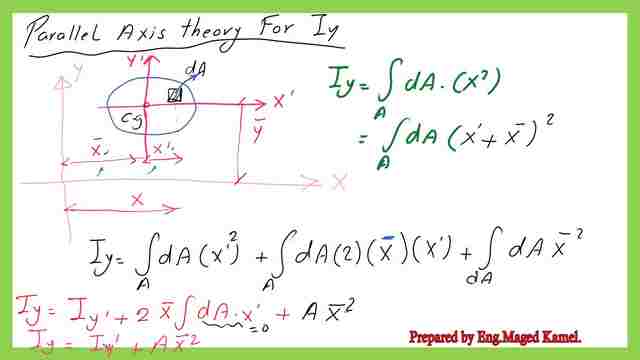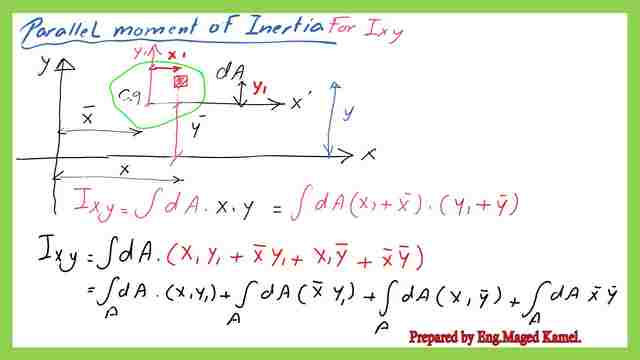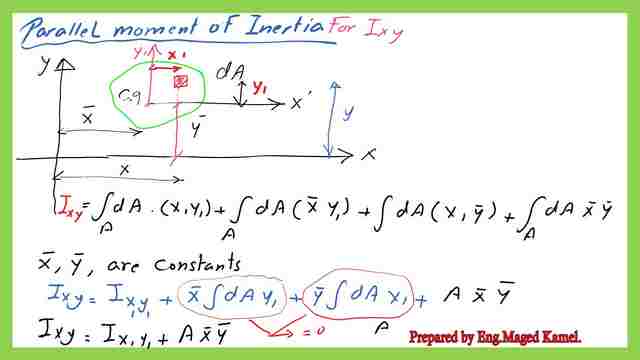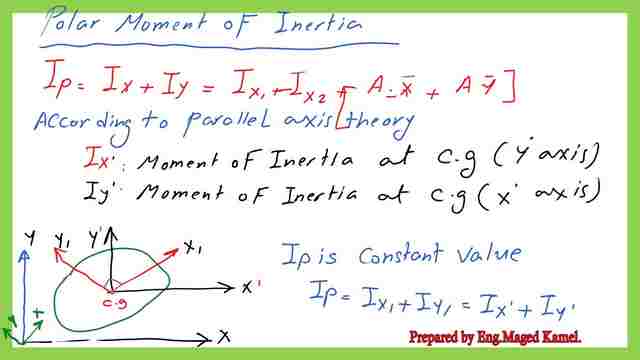Parallel Axis theorem For Iy, Polar Moment Of Inertia.
Parallel axes theorem proof for Iy.
We are going to talk about the parallel-axis theorem, For Iy. We have again two external axes. x and y. we are going to choose a small Infinitesimal area. We call it, dA and x ‘ and y’ are two axes passing by CG. of the area. The distance from the CG to the y-axis, we call it x̅. while the horizontal distance between the CG of the dA, to y’.
The horizontal axis passing by the CG is called x’ as we see and y̅ is the vertical distance from axis x’ to x.
If we are going to estimate the moment of inertia about this y-axis. It is the ∫ dA*x^2 distance x distance that can be estimated as the sum of two components.


Parallel axes theorem proof for Ixy.
For Ixy, the product-moment of area, again the same area. We are going to introduce x’ and y’, these are two axes passing by the CG, and the external two axes, as usual, are x and y, The distance from the CG is y̅.
To estimate the product-moment of area, we need to make integration by the multiplication of dA*x the horizontal distance * y to both x and y external axes.
Similarly, as before, this x = x̅ + x’ and, the, y overall distance= y̅ +y ‘, we put both two items inside brackets then the Ixy = ∫dA.
Then we multiply by x1* y1+ X1* y̅ + x̅ *y1 + x̅ * y̅.
We are going to investigate each item and see what it resembles The ∫ dA*x1*y1=+ ∫ dA* x̅ *y1+ ∫ dA*x1* y̅ + ∫ dA* x̅ *y bar. Since x̅ and y̅ are constant distances, they will come out. dA*x1*y1, this is the product-moment of inertia about the CG., and we are going to call them Ix1y1.
The second term x bar will come out, we left with dAy1+ y̅ will come out by the ∫ of dAx1, both these two terms, since the first moment of the area about x and y, are equal 0


These axes are passing by the CG. Then, these two terms will be canceled. The last term, which is the ∫ dA* x̅ * y̅, will =A * x̅ * y̅ at the end Ixy=Ix1y1, and the product of inertia about two axes passing by the CG+Area x̅ * y̅.


What is the polar moment of inertia Ip?
For the Polar moment of inertia, this is new a new expression. I polar, the moment of inertia is the summation of the moment of inertia about x moment of inertia about y and this will be considered as a constant value.
What does it mean? it means that for any two arbitrary orthogonal, this is supposed to be 90 degrees, the angle should be 90 degrees, at first we x’ and y axes pass by the CG, the I polar=Ix +Iy =Ix’+Iy’.
The moment of inertia, if you are going to discuss the CG Ix+Iy= Ix1 +Iy1.
We are going to say, that I polar =Ix +Iy, which means that again, we are going to write Ix1+A* x̅+Iy2+A* y̅ and if we are going again to select any two orthogonal axes passing by the (0,0). We can call them, whatever any name x & y, X and Y then the I polar, again will be = the summation of Ix+Iy.


What is the radius of gyration for x and y axes?
There is another term, we call it the radius of gyration for Ix = A* kx^2, so we can get an expression, that kx =sqrt of Ix/A. Similarly, Iy=A*ky^2, which means that ky=sqrt of Iy/A, we will consider that the area, for example for a rectangle that area is concentrated at the CG.
We will find out that when the area is concentrated at the center of gravity, then the first moment can be estimated as the multiplication of area by y̅, which is the vertical distance to the x-axis.
The difference between y̅ and k x lies in that the location of the point will be considered changed and the multiplication of the area *kx^2, will produce the second moment of area, that is why the Ix =A *kx^2 after considering that the concentration of area.


This is the PDF used in the illustration of this post.
For an external resource, Engineering core courses, the moment of inertia.
This is a link to my playlist on YouTube.
For the radius of gyration for more details from the wiki.
Next post: Moment of inertia Ix– for the rectangular section, what are the methods to estimate?

